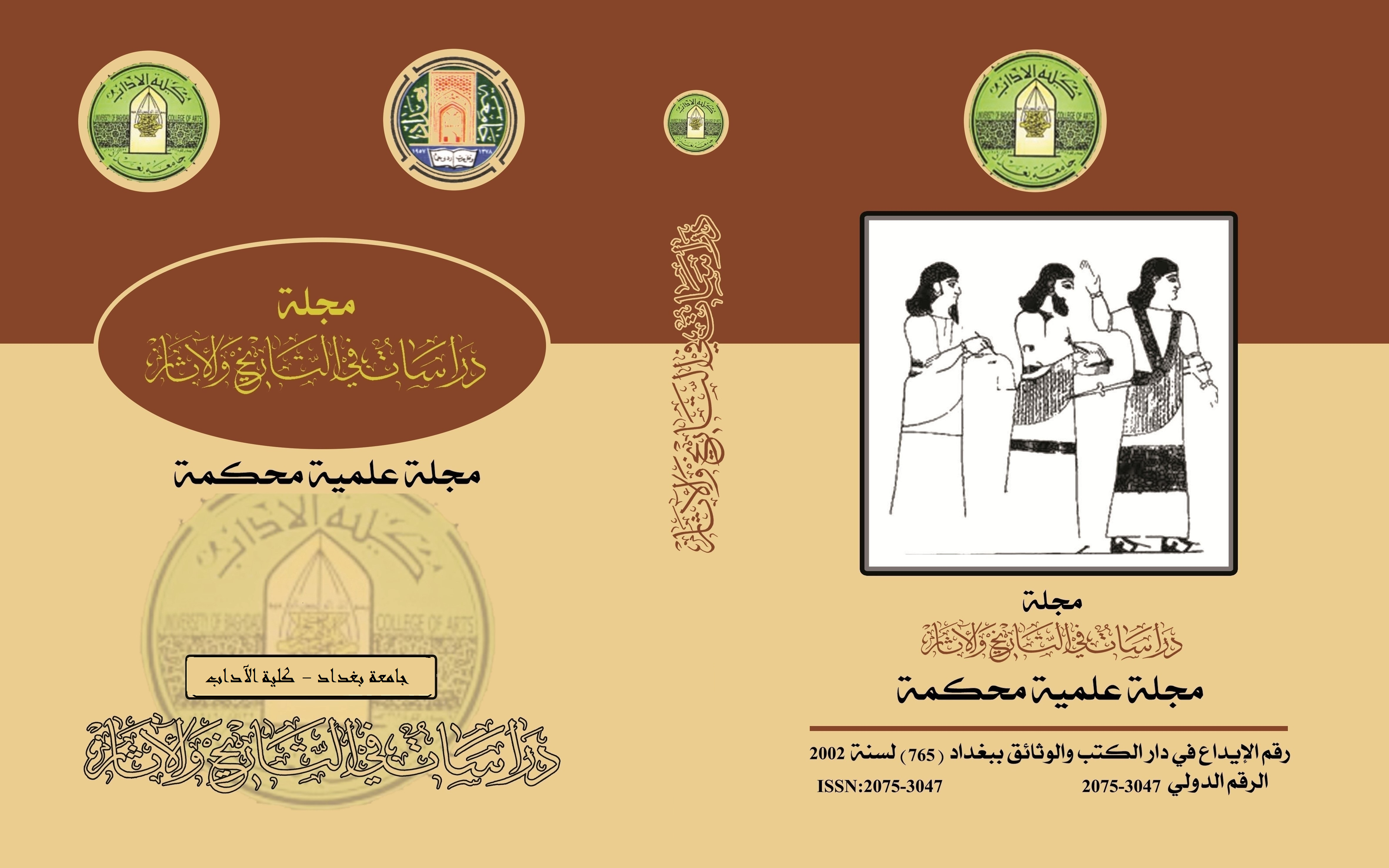الثلج استخداماته وطرق خزنه في بلاد الرافدين في ضوء النصوص المسمارية
الكلمات المفتاحية:
استخدام، خزن، ضوء، نصوصالملخص
كانت ولازالت مادة الثلج واستخداماته ضروريا في الحياة اليومية ، اذ تعكس مضامين النصوص المسمارية ذات العلاقة ان العراقيين القدماء كان لديهم اهتمام واضح بجلب قطع الثلج واساليب تجهيزه وحفظه في اماكن مخصصة للحيلولة دون ذوبانه بتأثير أشعة الشمس في الاجواء الحارة ، فقد اشير في العديد من مراسلات الملوك وحكام المقاطعات من العصر البابلي القديم الى جلب كميات الثلج من الاماكن الجبلية الشمالية اثناء فصل الشتاء وكانت تحمل وتنقل على الدواب لمسافات طويلة قد تستغرق من (10 بيرو – 20 بيرو) (والبيرو تبلغ حسب تقديراتنا الزمنية الحالية بنحو ساعتان) .
ويبدو انه كان للثلج استخدامات متعددة عند العراقيين القدماء فضلا عن استخداماته لتبريد مياه المشروبات الرائجة آنذاك ، كان يستخدم في المعالجات الطبية لتخفيف الالام وتخديرها عن طريق البرودة التي يحتويها الثلج ، كما يفهم من مضامين النصوص المسمارية ذات العلاقة توجيهات الملوك في العراق القديم حول عدم الاسراف في استخدامات قطع الثلج المحفوظ باستمرار وكل ما يتعلق بالحفاظ عليه وحسب حاجة الناس لأهميتها في حياتهم آنذاك.
المراجع
( ) الكحلاني، محمد بن اسماعيل بن صلاح بن محمد الحسني والصفاني، ابو ابراهيم، توضيح الافكار بمعاني تنقيح الانظار، ج2، بيروت، 1997، ص21.
( ) ابن منظور، أبو الفضل جمال الدين محمد بن مكرم، لسان العرب، القاهرة، (ب.ت)، ص500.
( ) الحسيني، محمد بن محمد بن عبد الرزاق، تاج العروس من جواهر القاموس، ج5، القاهرة، 1984، ص447.
( ) ابن منظور، المصدر السابق، ص500.
( ) المقدسي، عبد الغني بن عبد الواحد، عمدة الاحكام من كلام خير الأنام، ج1، قرطبة، 1408هـ-1988م، ص48.
وكذلك ينظر: ابو سعيد، فؤاد بن يوسف، شرح حديث اللهم باعد بيني وبين خطاياي، مقالة – آفاق الشريعة الحرم المكي، 2018، ص1.
( ) الفارابي، أبو نصر اسماعيل بن حماد الجوهري، الصحاح تاج اللغة وصحاح العربية، ج1، بيروت، 1987، ص302.
( ) الفارابي، ابو ابراهيم اسحاق بن ابراهيم بن الحسين، معجم ديوان الأدب، ج2، القاهرة، 2003، ص151.
( ) المصدر نفسه، ص151.
( ) الفارابي، ابو نصر اسماعيل بن حماد الجوهري، المصدر السابق، ص950.
( ) الدمشقي، احمد بن مصطفى، معجم اسماء الأشياء المسمى اللطائف في اللغة العربية، ج1، القاهرة، 1318هـ، ص15.
( ) CAD, Š/3, p. 347: b.
( ) CDA, Ḫ, p. 102.
( ) يمكن القول ان قاعدة الابدال المكاني بين الحروف في الاكدية والعربية مطابقة تماماً في استخدام هذا المصطلح فاحياناً ما يقابل حرف ش š الاكدي حرف الثاء العربي ومثال ذلك šalgu بمعنى ثلج، صقيع. ينظر: سليمان، عامر، اللغة الاكدية، الموصل، 1991، ص189.
كذلك ينظر:
CDA, Š/3 p. 102.
( ) CAD, Š/3, p. 348: b.
( ) الجبوري، علي ياسين، قاموس اللغة الاكدية – العربية، ابو ضي، 2010، ص293.
( ) الالهة انانا: عشتار الهه الحب والجمال والحرب وحسب قوائم الالهة وانسابها تعد انانا ابنة الاله سين اله القمر وامها الالهة ننكال وكانت مدينة الوركاء مركزاً لعبادتها. ينظر:
Leick, G., A Dictionary of Ancient Near Eastern Mythology, ISBIN, P. 87-88.
( ) أريدو: مدينة سومرية تعرف اليوم ابو شهرين تقع في القسم الجنوبي في بلاد الرافدين وعلى بعد 40 كم إلى الغرب من مدينة الناصرية وتعد المدينة مركزاً لعبادة الاله انكي/ ايا اله المياه العذبة. بصمه جي، فرج، كنوز المتحف العراقي، بغداد، 1972، ص4.
( ) الاله انكي/ ايا: اله الماء السحر والحكمة يأتي بالمرتبة الثالثة بعد الاله انو والاله انليل يتألف اسمه من مقطعين، المقطع الأول EN بمعنى سيد والمقطع الثاني KI أي الأرض فيكون معنى اسمه سيد الأرض، وتعد مدينة اريدو مقراً لعبادته. ينظر:
Leick, G., Op. Cit., P. 40.
( ) مدينة الوركاء: عرفت المدينة في اللغة السومرية UNUGki وفي اللغة الاكدية uruk تقع على بعد 30 كم جنوب شرق مدينة السماوة وشمال غرب موقع مدينة اور وعدت المدينة مركزاً لعبادة الاله انو والالهة عشتار. ينظر: اسماعيل، خالد سالم، اضواء على اصول الكتابة الصورية (الاركائية)، مجلة آداب الرافدين، العدد 36، 2003، ص161. كذلك ينظر:
Van Buren, E.D., Symbols of the God in Mesopotamia Art, London, 1945, P. 46.
( ) كريمر، صموئيل نوح، الاساطير السومرية، ترجمة: يوسف داؤد عبد القادر، بغداد، 1971، ص109.
( ) تعد الالهة شالا الهة الجبال
التنزيلات
منشور
إصدار
القسم
الرخصة

هذا العمل مرخص بموجب Creative Commons Attribution 4.0 International License.
:حقوق الطبع والنشر والترخيص
بالنسبة لجميع البحوث المنشورة في مجلة دراسات في التاريخ والآثار، يحتفظ الباحثون بحقوق النشر. يتم ترخيص البحوث بموجب ترخيص Creative Commons CC BY 4.0 المفتوح ، مما يعني أنه يجوز لأي شخص تنزيل البحث وقراءته مجانًا. بالإضافة إلى ذلك ، يجوز إعادة استخدام البحث واقتباسه شريطة أن يتم الاستشهاد المصدر المنشور الأصلي. تتيح هذه الشروط الاستخدام الأقصى لعمل الباحث وعرضه.
:إعادة إنتاج البحوث المنشورة من الناشرين الآخرين
من الضروري للغاية أن يحصل الباحثون على إذن لإعادة إنتاج أي بحث منشورة (أشكال أو مخططات أو جداول أو أي مقتطفات من نص) لا يدخل في نطاق الملكية العامة أو لا يملكون حقوق نشرها. يجب أن يطلب الباحثون إذنًا من مؤلف حقوق النشر (عادة ما يكون الناشر).
يطلب الإذن في الحالات التالية:
بحوثك الخاصة المنشورة من قِبل ناشرين آخرين ولم تحتفظ بحقوق النشر الخاصة بها.
مقتطفات كبيرة من بحوث أي شخص أو سلسلة من البحوث المنشورة.
استخدم الجداول والرسوم البيانية والمخططات والمخططات والأعمال الفنية إذا لم يتم التعديل عليها.
الصور الفوتوغرافية التي لا تملك حقوق لنشرها.
لا يطلب الإذن في الحالات التالية:
إعادة بناء الجدول الخاص بك مع البيانات المنشورة بالفعل في مكان آخر. يرجى ملاحظة أنه في هذه الحالة يجب عليك ذكر مصدر البيانات في شكل "بيانات من ..." أو "مقتبس من ...".
تعتبر عروض الأسعار القصيرة معقولة الاستخدام العادل ، وبالتالي لا تتطلب إذنًا.
الرسوم البيانية ، الرسوم البيانية ، المخططات ، الأعمال الفنية التي أعاد الباحث رسمها بالكامل والتي تم تغييرها بشكل ملحوظ إلى درجة لا تتطلب الاعتراف.
الحصول على إذن
لتجنب التأخير غير الضروري في عملية النشر ، يجب أن تبدأ في الحصول على أذونات في أقرب وقت ممكن. لا يمكن لمجلة الآداب نشر بحث مقتبس من منشورات أخرى دون إذن.
قد يمنحك مالك حقوق الطبع والنشر تعليمات بشأن شكل الإقرار الواجب اتباعه لتوثيق عمله ؛ بخلاف ذلك ، اتبع النمط: "مستنسخ بإذن من [المؤلف] ، [كتاب / المجلة] ؛ نشره [الناشر] ، [السنة]." في نهاية شرح الجدول ، الشكل أو المخطط.



















